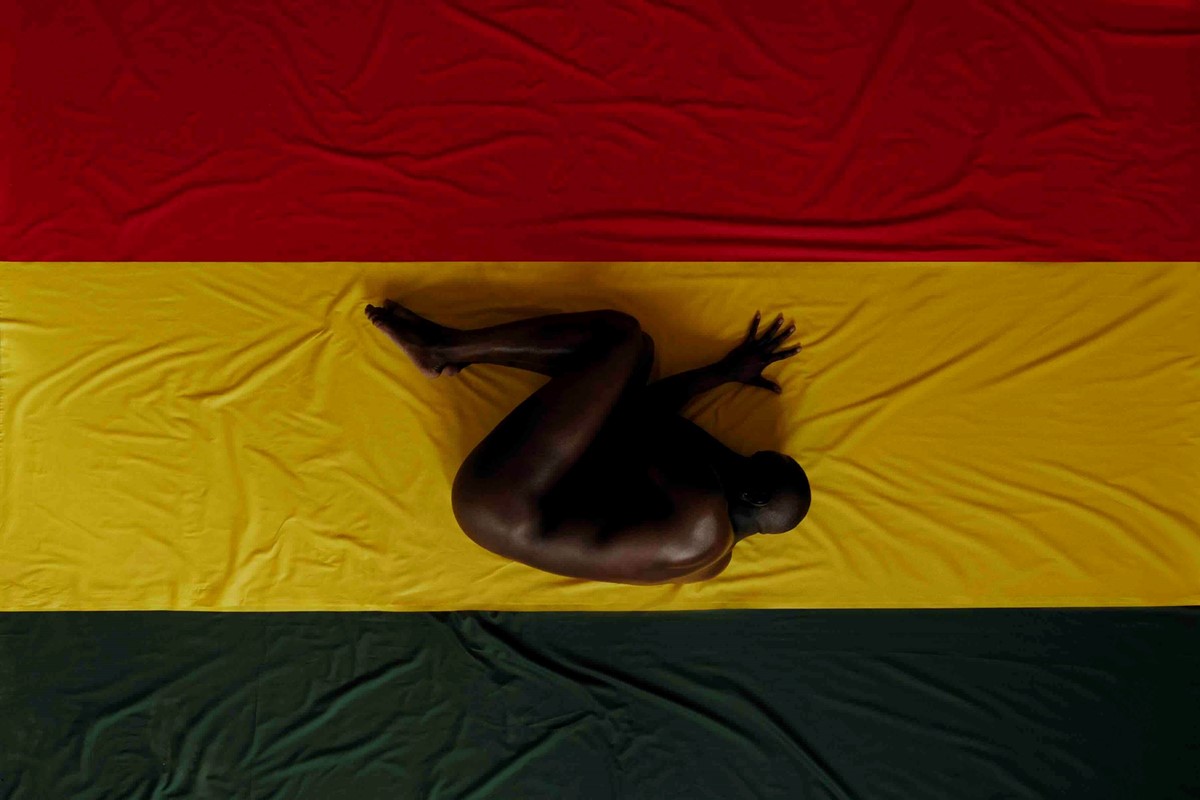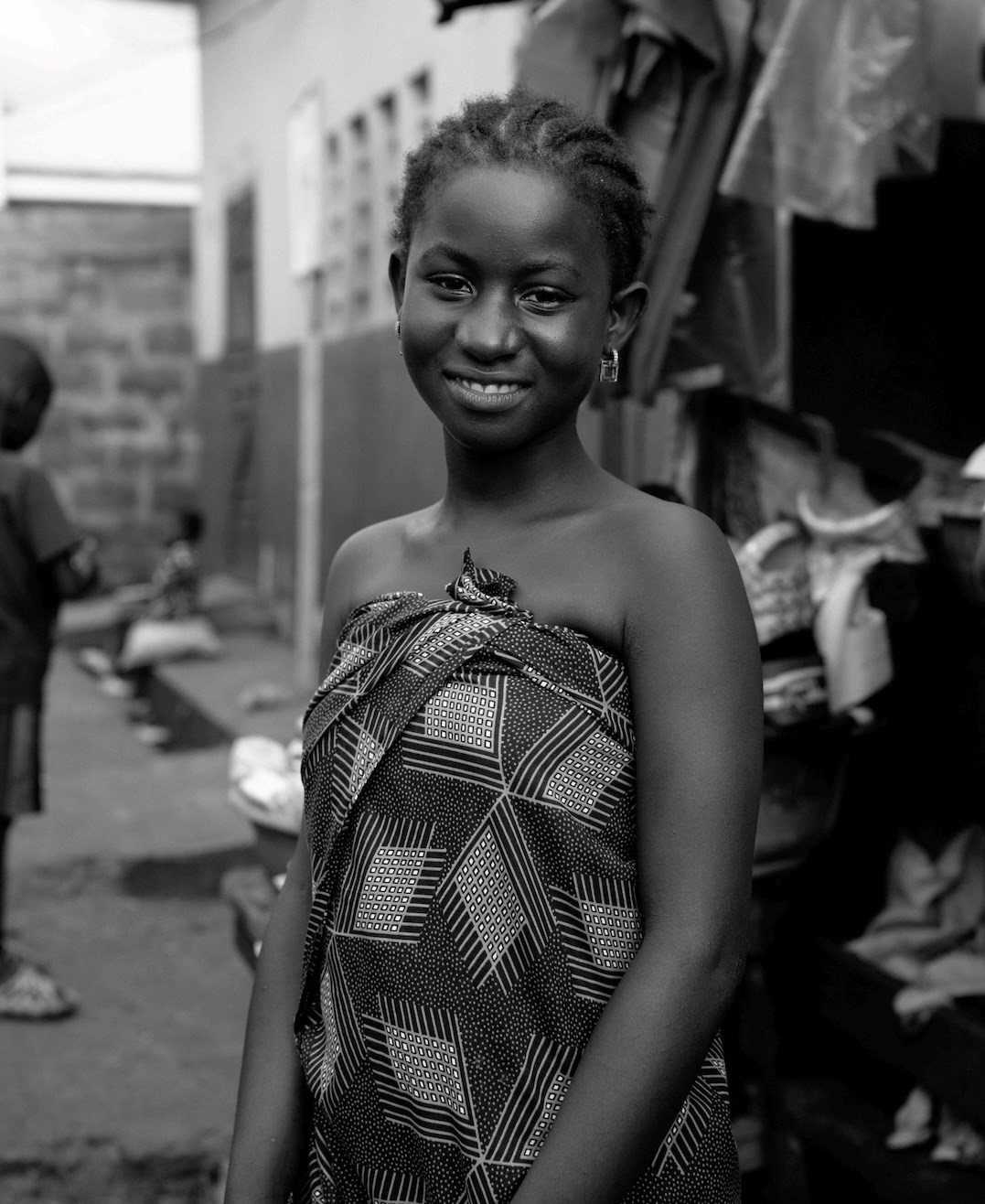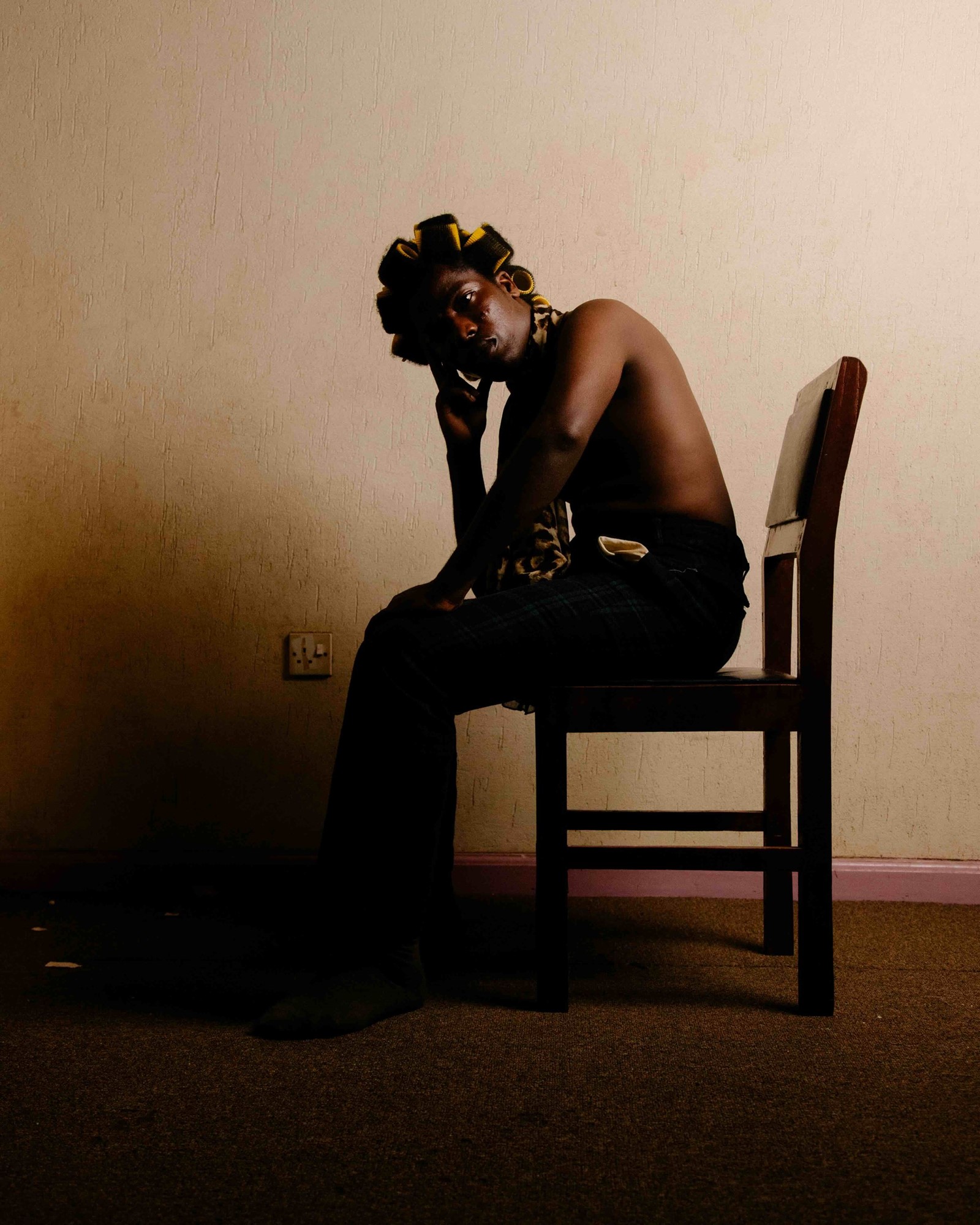
Rewrite
As Campbell Addy relaunches the magazine he started at university, he sits down with Alayo Akinkugbe to discuss the publication, LGBTQ+ rights in Ghana and why his motto is ‘here to educate, not irritate’
Campbell Addy is the London based Ghanaian-British photographer, filmmaker and artist who is widely recognised for his fashion photography. He’s also behind the magazine, Niijournal. “I’m a big believer in having multiple hats as an artist,” he explains. Niijournal began in 2016, as Addy’s graduation project at Central Saint Martins, with the aim to address the lack of Black representation in fashion and culture magazines.
The fourth edition of Niijournal, with the theme Pride?, is the first to be released since 2018. After a six-year hiatus – during which Addy’s career has gone from strength to strength – Niijournal has provided a space for Addy to explore creatively, tell important stories beyond his own work and present photography that he would not show in an exhibition or a magazine commission.
The motto of Niijournal remains, “here to educate, not irritate”. Issue 4 – international in scope – explores questions surrounding both queer pride and national pride, following the anti-LGBTQ+ legislation passed in Ghana in February this year.
In the following conversation, Addy speaks to Dazed about the birth of Niijournal, the importance of Black archives and his belief that “humans are all stars”.
This is the first issue of Niijournal since 2018, why does now feel like the right time to bring it back?
Campbell Addy: Niijournal started as my final major project at Uni in 2016, and [the subsequent issues] came out in 2017 and 2018. But then, a lot was happening in my life and I didn’t want to just do it for the sake of doing it. I wanted to have control over my space without having to compete with a publishing schedule and release it biannually. I always say to people, take your time, your timeline is your own.
After [my exhibition] I ♥ Campbell, I had many ideas that weren’t about me and my work, so I was like, ‘I guess Niijournal is coming about”. But the real catalyst was Ghana trying to pass the bill on February 28. And then I wrote down a poem called Feb 28. I had the fire in me, I knew what I want to talk about, and I had unknowingly been doing research towards that anyway. I knew exactly what the cover was going to be and I knew what string of connection throughout the magazine was going to be. And it’s queerness, it’s pride and it’s community.
You were still studying at Central Saint Martins when you started Niijournal in 2016, what spurred you on at that time to create it?
Campbell Addy: It was originally just going to be a photo book but my tutor at the time, Judith Watt, asked me, ‘Are you just a photographer?’ She said, ‘Just think about it.’ And I remember thinking ‘I can’t write, I have dyslexia,’ and she said, ‘Write how you want to write, not how you think you should write.’
So I just started building this thing called the Bible, it’s [still] in my studio, and it was just a scrapbook of thoughts. It was a solid place, that wasn’t digital. Then I [realised] I wanted to make a diary – a journal – of everything that I’m interested in. I may take pictures, but I have other talents. She spurred on to keep pushing and that’s when Niijournal was born. I was able to collaborate with people, while still doing me. And it was a place to put photography work that I didn’t think would be accepted; at the time there weren’t any black photographers in the popular limelight of photography.


Is Niijournal based on your aesthetic language as a photographer and filmmaker?
Campbell Addy: Yes and no. I was just flicking through the magazine now and I thought, ‘I know I’ve taken these photographs but it feels like a new language in my evolution of image-making.’ But then it still has the same language as Niijournal I, where I was literally embedding subliminal messages into my work. You know, I think it’s the mature eye of Campbell Addy. There’s tropes of me, but aesthetically, [for example] if it was in a gallery and there was no caption, you [wouldn’t] necessarily be like, ‘Oh, that’s Campbell.’
So Niijournal is the right place for these images.
Campbell Addy: Exactly. All the images are created for Niijournal. I don’t know if I could put them in another magazine and, [they] would have the same cultural relevance.
“I’m excited by [our] differences, but I’m enamored by our similarities. I hope people look at this and understand that history will repeat itself, and understand that we can resist in a way that is poetically inclined with our soul” – Campbell Addy
The motto of Niijournal is ‘here to educate, not irritate’. Where does that motto originate?
Campbell Addy: The same tutor who [encouraged] me to do Niijournal gave me a little book on Ignatius Sancho. It was so simple and I don’t think she understood the gravitas it had on me; reading about a Black man who was a poet and had a grocery store in a time when I thought we were just enslaved. It just cracked my mind.
I just couldn’t shut up [about it], I was on forums on Facebook talking about it. Naively, I didn’t realise the backlash I was going to get [online]. I understood racism was rife, but I didn’t understand it was also fucking dumb. It’s like what Tina Knowles says [in Solange Knowles’ album A Seat At the Table] ‘because you celebrate Black culture does not mean that you don’t like white culture; or that you putting it down. It’s just taking pride.’
After writing a Facebook post, I had a conversation with a childhood friend that led to an argument. And at the end I said, ‘I’m just here to educate, I’m not trying to irritate you.’ And that is the whole crux of my existence. That’s where it came from.
The imagery is international but the focus seems to remain on Black experiences.
Campbell Addy: The initial inspiration is always based on what I want to see, and [in this case it was] Black queerness. But also it’s educational, this issue is very journalistic. There’s a whole essay and story about Mao Ishikawa, a famous Japanese photographer. She’s in the magazine because in the 70s in Okinawa, there was an American army base and there were a lot of Black and Japanese relationships. She documented that, and her essays and photography comment on racial inequality. There’s a whole Black in Japan section [in the journal].


How did you choose the theme Pride? for this issue of Niijournal?
Campbell Addy: It’s a double entendre. It refers to the [Ghanian anti-LGBTQ+] legislation, but also to national pride. On the cover, a person lies over the Black Star [of the Ghanaian flag] because we are black stars. Humans are all stars and I feel like that was forgotten when they were doing the legislation on February 28. [The image] is trying to resemble a star but also to resemble the feeling of when your country goes against you for your existence.
The back cover refers to pageant girls because they’re so proud to be from their country. That got me thinking about how, despite the trials and tribulations that queer people experience, we are still proud of where we’re from. But where is the pride coming from if you’re making us illegal? The flags worn by [the models on the back cover] are the countries that made LGBTQ+ people illegal in some way or form.
What do you hope readers will take away from this issue?
Campbell Addy: My gut says, I hope people understand how different we aren’t. I’m excited by [our] differences, but I’m enamored by our similarities. I hope people look at this and understand that history will repeat itself, and understand that we can resist in a way that is poetically inclined with our soul. You ain’t going to see me on no battlefield with a gun, but I’m going to make sure I document it. And I hope people understand that a Black archive is important.
Someone will look at this in 40 years, and I hope they laugh and go ‘wow, Ghana tried that?’ I hope people get inspired to shine light on the things that really matter, because the world is so bleak sometimes, but hope is what will change it.
Niijournal Issue 4: Pride? is out now. Head here to buy a copy.
in HTML format, including tags, to make it appealing and easy to read for Japanese-speaking readers aged 20 to 40 interested in fashion. Organize the content with appropriate headings and subheadings (h1, h2, h3, h4, h5, h6), translating all text, including headings, into Japanese. Retain any existing
tags from
As Campbell Addy relaunches the magazine he started at university, he sits down with Alayo Akinkugbe to discuss the publication, LGBTQ+ rights in Ghana and why his motto is ‘here to educate, not irritate’
Campbell Addy is the London based Ghanaian-British photographer, filmmaker and artist who is widely recognised for his fashion photography. He’s also behind the magazine, Niijournal. “I’m a big believer in having multiple hats as an artist,” he explains. Niijournal began in 2016, as Addy’s graduation project at Central Saint Martins, with the aim to address the lack of Black representation in fashion and culture magazines.
The fourth edition of Niijournal, with the theme Pride?, is the first to be released since 2018. After a six-year hiatus – during which Addy’s career has gone from strength to strength – Niijournal has provided a space for Addy to explore creatively, tell important stories beyond his own work and present photography that he would not show in an exhibition or a magazine commission.
The motto of Niijournal remains, “here to educate, not irritate”. Issue 4 – international in scope – explores questions surrounding both queer pride and national pride, following the anti-LGBTQ+ legislation passed in Ghana in February this year.
In the following conversation, Addy speaks to Dazed about the birth of Niijournal, the importance of Black archives and his belief that “humans are all stars”.
This is the first issue of Niijournal since 2018, why does now feel like the right time to bring it back?
Campbell Addy: Niijournal started as my final major project at Uni in 2016, and [the subsequent issues] came out in 2017 and 2018. But then, a lot was happening in my life and I didn’t want to just do it for the sake of doing it. I wanted to have control over my space without having to compete with a publishing schedule and release it biannually. I always say to people, take your time, your timeline is your own.
After [my exhibition] I ♥ Campbell, I had many ideas that weren’t about me and my work, so I was like, ‘I guess Niijournal is coming about”. But the real catalyst was Ghana trying to pass the bill on February 28. And then I wrote down a poem called Feb 28. I had the fire in me, I knew what I want to talk about, and I had unknowingly been doing research towards that anyway. I knew exactly what the cover was going to be and I knew what string of connection throughout the magazine was going to be. And it’s queerness, it’s pride and it’s community.
You were still studying at Central Saint Martins when you started Niijournal in 2016, what spurred you on at that time to create it?
Campbell Addy: It was originally just going to be a photo book but my tutor at the time, Judith Watt, asked me, ‘Are you just a photographer?’ She said, ‘Just think about it.’ And I remember thinking ‘I can’t write, I have dyslexia,’ and she said, ‘Write how you want to write, not how you think you should write.’
So I just started building this thing called the Bible, it’s [still] in my studio, and it was just a scrapbook of thoughts. It was a solid place, that wasn’t digital. Then I [realised] I wanted to make a diary – a journal – of everything that I’m interested in. I may take pictures, but I have other talents. She spurred on to keep pushing and that’s when Niijournal was born. I was able to collaborate with people, while still doing me. And it was a place to put photography work that I didn’t think would be accepted; at the time there weren’t any black photographers in the popular limelight of photography.


Is Niijournal based on your aesthetic language as a photographer and filmmaker?
Campbell Addy: Yes and no. I was just flicking through the magazine now and I thought, ‘I know I’ve taken these photographs but it feels like a new language in my evolution of image-making.’ But then it still has the same language as Niijournal I, where I was literally embedding subliminal messages into my work. You know, I think it’s the mature eye of Campbell Addy. There’s tropes of me, but aesthetically, [for example] if it was in a gallery and there was no caption, you [wouldn’t] necessarily be like, ‘Oh, that’s Campbell.’
So Niijournal is the right place for these images.
Campbell Addy: Exactly. All the images are created for Niijournal. I don’t know if I could put them in another magazine and, [they] would have the same cultural relevance.
“I’m excited by [our] differences, but I’m enamored by our similarities. I hope people look at this and understand that history will repeat itself, and understand that we can resist in a way that is poetically inclined with our soul” – Campbell Addy
The motto of Niijournal is ‘here to educate, not irritate’. Where does that motto originate?
Campbell Addy: The same tutor who [encouraged] me to do Niijournal gave me a little book on Ignatius Sancho. It was so simple and I don’t think she understood the gravitas it had on me; reading about a Black man who was a poet and had a grocery store in a time when I thought we were just enslaved. It just cracked my mind.
I just couldn’t shut up [about it], I was on forums on Facebook talking about it. Naively, I didn’t realise the backlash I was going to get [online]. I understood racism was rife, but I didn’t understand it was also fucking dumb. It’s like what Tina Knowles says [in Solange Knowles’ album A Seat At the Table] ‘because you celebrate Black culture does not mean that you don’t like white culture; or that you putting it down. It’s just taking pride.’
After writing a Facebook post, I had a conversation with a childhood friend that led to an argument. And at the end I said, ‘I’m just here to educate, I’m not trying to irritate you.’ And that is the whole crux of my existence. That’s where it came from.
The imagery is international but the focus seems to remain on Black experiences.
Campbell Addy: The initial inspiration is always based on what I want to see, and [in this case it was] Black queerness. But also it’s educational, this issue is very journalistic. There’s a whole essay and story about Mao Ishikawa, a famous Japanese photographer. She’s in the magazine because in the 70s in Okinawa, there was an American army base and there were a lot of Black and Japanese relationships. She documented that, and her essays and photography comment on racial inequality. There’s a whole Black in Japan section [in the journal].


How did you choose the theme Pride? for this issue of Niijournal?
Campbell Addy: It’s a double entendre. It refers to the [Ghanian anti-LGBTQ+] legislation, but also to national pride. On the cover, a person lies over the Black Star [of the Ghanaian flag] because we are black stars. Humans are all stars and I feel like that was forgotten when they were doing the legislation on February 28. [The image] is trying to resemble a star but also to resemble the feeling of when your country goes against you for your existence.
The back cover refers to pageant girls because they’re so proud to be from their country. That got me thinking about how, despite the trials and tribulations that queer people experience, we are still proud of where we’re from. But where is the pride coming from if you’re making us illegal? The flags worn by [the models on the back cover] are the countries that made LGBTQ+ people illegal in some way or form.
What do you hope readers will take away from this issue?
Campbell Addy: My gut says, I hope people understand how different we aren’t. I’m excited by [our] differences, but I’m enamored by our similarities. I hope people look at this and understand that history will repeat itself, and understand that we can resist in a way that is poetically inclined with our soul. You ain’t going to see me on no battlefield with a gun, but I’m going to make sure I document it. And I hope people understand that a Black archive is important.
Someone will look at this in 40 years, and I hope they laugh and go ‘wow, Ghana tried that?’ I hope people get inspired to shine light on the things that really matter, because the world is so bleak sometimes, but hope is what will change it.
Niijournal Issue 4: Pride? is out now. Head here to buy a copy.
and integrate them seamlessly into the new content without adding new tags. Ensure the new content is fashion-related, written entirely in Japanese, and approximately 1500 words. Conclude with a “結論” section and a well-formatted “よくある質問” section. Avoid including an introduction or a note explaining the process.


